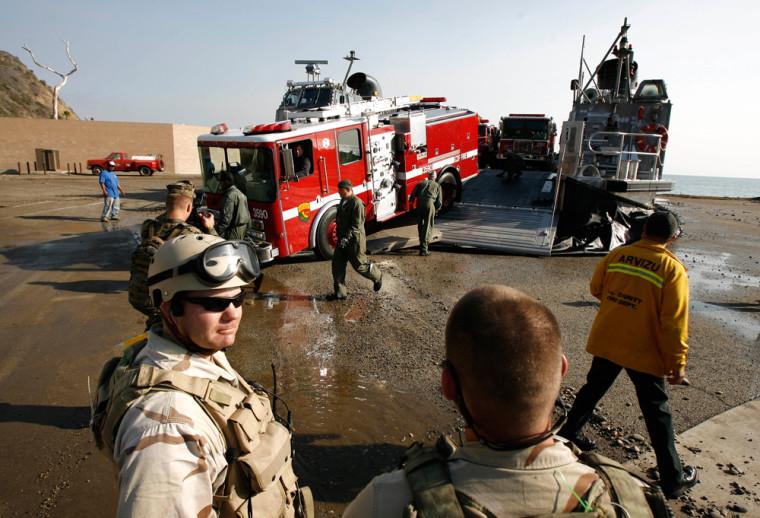Weeks into a wildfire season that has already burned parts of Catalina Island, Los Angeles and Lake Tahoe, swaths of California’s flammable national forests are some days protected by nothing more than luck.
On any given day, about 40 of 271 U.S. Forest Service engines remain in firehouses rather than on patrol, idled by a shortage of supervisors. Meanwhile, the combined effects of sustained drought, last winter’s freeze and a searing heat wave has dramatically raised fire danger levels this season.
An exodus of highly trained mid- and upper-level firefighters from the career ranks of the federal agency is at least partly to blame for the fact that 13 percent of the service’s 3,600 full-time positions in California are vacant.
“When you start leaving holes in your organization so that on a given high-danger day you can’t provide coverage, you’ve set yourself up for trouble,” said John Marker, a retired former Forest Service district ranger on the Sequoia National Forest.
Retirees return to jobs
Nationally, fire planners from all five federal agencies that handle firefighting are dealing with the departure of a generation of top managers hired during a firefighting expansion in the late 1970s. That has left behind too few career firefighters qualified to run engines, oversee forests or command large fire operations.
As forests from the Mexico border to Canada reassign engine crews, top-level teams working for other agencies are simply hiring recent retirees. Of 50 people working on one federal interagency team based in the Great Basin states, 10 are due to retire in the next two years, and a handful have come out of retirement as emergency hires this season.
“We haven’t been able to fill out teams so we keep bringing back the old warhorses,” said Paul Broyles, who heads the team.
California has been hit harder than other states because the high cost of living has deterred recruits from moving here, and state and local agencies are siphoning federal managers with higher pay and better benefits.
Forest Service officials have filled nearly 800 positions since last October but are still short about 470 people.
“There are a lot of people lower down in the system who are five or six years away from being able to compete for leadership jobs,” said Ed Hollenshead, regional director of fire and aviation management for the Forest Service. “It’s like a slinky — sometimes it’s bunched up, but right now the slinky is stretched out.”
Takes longer to control blazes?
The hardest-hit areas include the Angeles and San Bernardino National Forests, where only 60 to 70 percent of engines are being regularly staffed because there are too few qualified supervisors to go around, said Mike Dietrich, acting deputy director of fire and aviation for the Forest Service’s Region 5, which encompasses all of California.
Those forests border on heavily populated urban areas, potentially raising the risk to people living nearby.
“It’s going to take them longer to get to these fires,” said Doug Campbell, a retired Forest Service fire planner who now trains various agencies on fire behavior.
None of the big fires so far this season have gotten out of hand because of short staffing, and officials said they are confident California has enough resources available to get through the next six months.
With 1,600 seasonal hires, the Forest Service is fielding 5,200 firefighters this year. Chiefs on California’s 18 national forests, which cover about 20 percent of the state, can call on their counterparts in other federal firefighting units or the California Department of Forestry and Fire Protection, which has 8,400 people available this summer, said Ken McLean, deputy state director of fire protection.
California’s robust mutual aid system also activates thousands of engines working for myriad municipal and county departments in large fires.
Covering gaps
Despite the shortages of engine crews, the Forest Service’s teams of smokejumpers and hotshots are filled.
Engine crews are being moved around the state as weather-related fire risk levels change, Hollenshead said. The region has also won an extra complement of 15 federal helicopters to beef up capacity for the first crucial hours of a blaze.
The agency has won approval to begin a massive hiring push starting next week to fill the roughly 470 captain, engineer, dispatcher and other specialist vacancies before the fall, Dietrich said. Those critical staff members manage individual engines and direct the army of entry-level and seasonal “water-squirters” in fire prevention tasks once big fires hit.
Firefighting crews and equipment from other parts of the country are also being moved into California and the rest of the West, said Tom Harbour, national director of fire and aviation for the Forest Service.
“We move those assets around to cover gaps in specific area, and the focus for us now is the West,” he said.
